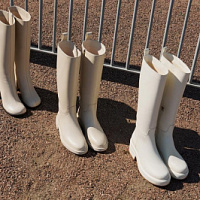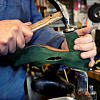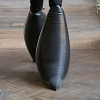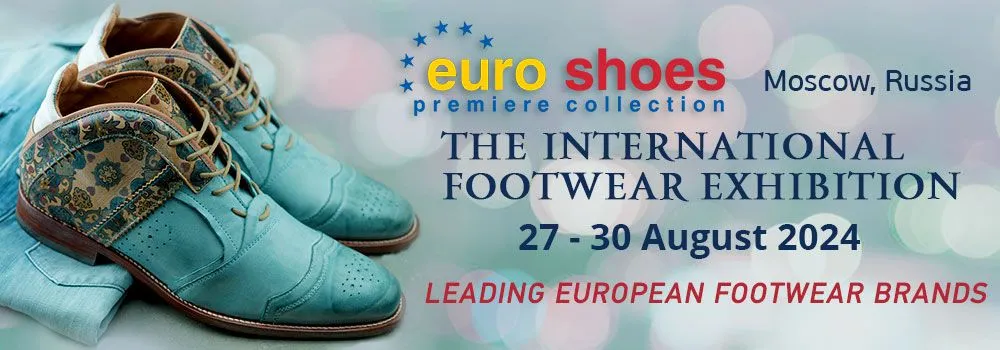
Five components that hamper the development of retail sales of shoes and accessories

 Evgeny Danchev -
Evgeny Danchev -
business coach, consultant, expert in increasing sales of the fashion market. Author of the book "A Practical Guide to Increasing Sales of Shoes and Accessories". Author of sales scripts "60 responses to customer objections in a retail shoe store" and "Standards for retail shoe sales." Creator of an online school for fashion market leaders.
@evgenydanchev, www.wconsulting.su
For examples that confirm these words, you do not need to go far. Look at your market neighbors. There are always 2-3 major players who keep 30-40% of all sales in your city. These are market leaders who, despite the crisis, not only retain their share, but in some cases increase it. And due to what they do it? They are well aware of those very key points of control and, in an unfavorable external situation, strengthen control over them.
In this article, we will analyze five mistakes (components) that companies make in the market of shoes and accessories. These errors are directly related to control points. All the errors that will be discussed are identified in practice - while working with companies selling shoes and accessories.
Error № 1
The leaders have the belief that the current collection, which is sold in a certain phase of the season, should be sold as much as possible by the end of the season and that large stocks of the product are bad.
In fact, if you follow this belief, then, for example, in the last month of winter (February), a limited number of models will remain on the shelves and, most unpleasantly, the size depth will also drop dramatically. For example, in February I conducted an experiment in one of the stores and checked the availability of sizes for models on one shelf. In fact, it turned out that of the 23 models, only three have a full size range; for other models - from one to three sizes. Now put yourself in the shoes of the customer: you come to the store, choose the model you like, and the seller tells you that there is no size ... Take the second model, and also not. You are disappointed to leave the store, and the main question - whether you will return to it in the future - remains open.
It is clear that by the end of the season the size range of models may be reduced, but it is important to understand that the client needs shoes of the right size, and not a wide range, where 70% or more are balances of one or two sizes. Following the logic of reducing balances by the end of the season, many company leaders themselves came up with the myth that February and August are two months of sales, when the company makes almost nothing or even works at a loss. Yes, in these months, of course, you need to sell balances with discounts, but there are solutions that allow you to increase sales and at the same time lose less in margins.
First of all, you need to optimize the assortment. It is better for some models to increase the number of pairs in the purchase, thereby reducing the total number of models. What does it give? Psychologists conducted more than one experiment on the topic of a wide selection of assortment. Consistently, buyers purchased more goods not in those stores where the widest choice, but where it is the most optimal. Too wide assortment, on the contrary, often confuses customers, many are simply lost (we do not take examples of grocery hypermarkets).
Only you can make a conclusion about your wide assortment or the optimal one, but the guideline is as follows: the size range should be present even at the end of the current season, if not on 100%, then at least on 50% models. Of course, managers are often worried about the remains of shoes in warehouses, and the fact that these are frozen funds of the company for the coming 5-6 months. Yes, part of the product will remain for sale next season and will be sold with a new collection, but at the same time, its presence at the end of the season allows you to earn money, and not work at zero or loss. When working in the shoe business, you must accept from the outset that part of the product will always be in stock and wait "for its turn."
Another way to minimize No. 1 error is to increase shelf space at the end of the season for year-round models. You all know very well that there is part of the assortment that is sold all year round. For these models, the size range should be maximum. In shoe companies, for some reason they forget about it and divide the collections by season. And this again leads to a drop in sales and loss of profit. In modern business, the phrase "lost profit" comes to the fore. It used to be, before the 2008 crisis of the year, the shoes themselves were on sale, but now they need to be sold. And if the head of the company does not understand that it is impossible to work with the assortment like 7-8 years ago, then sales will be highly susceptible to external factors. Therefore, the recommendation is as follows: include models with a year-round sales cycle in your product range matrix, and this will definitely add you sales and profits.

Error № 2
Lack of certification of sellers by product.
Most company executives believe that my sellers know the product. But when a “mystery shopper” appears at the point of sale and begins to ask sellers questions about the quality of the leather, about how it differs from the leather substitute, about the brand, country of manufacture, etc., the answers are sometimes simply shocking. More than once I had to listen to sellers telling all sorts of tales, coming up with on the go, there were cases when they simply went to the warehouse and did not return - just not to answer tricky questions and not get into an uncomfortable position.
Therefore, any seller-consultant, before allowing him to communicate with the buyer, should receive a document, “Product Standards”, which will describe the main properties of the product and the distinctive features and characteristics (brand history, if any). And only after that it is necessary to compile a questionnaire from 20-30 questions and make sure that the seller knows the answers to them, after attestation.
Why is this so important to do? Because customers are more likely to buy shoes and accessories from those sellers who more fully and competently talk about their product, explaining why prices for a particular product are higher than those of competitors.
Error № 3
Ignorance by sellers of sales techniques.
As before, more than 90% of sellers in retail trade start a conversation with a customer with trivial questions: “Can you tell me something?” Or “Can I help you with something?”. 80% of customer responses to this question will be, at best, "No, thanks." At worst, you can run into an answer with "sarcasm." And only 20% of customers support a conversation with the seller after this phrase.
Further - more: if it was possible to establish contact with the buyer, the seller quickly proceeds to a premature presentation and begins to comment on each model of shoes or accessories that the client is looking at. The problem is that the seller, bypassing the stage of diagnosis of needs, goes to the stage of presentation, and works on the principle of "guide", which gives comments to each pair of shoes. Sellers do this without knowing the rules for choosing a product by the client - “I look at the product, and I like it — I do not always buy it anyway.” Not knowing the true needs of the buyer, sellers are forced to respond to external manifestations and visitor behavior. And if a client, walking around the store, looked at several models, held them in his hands, and then left the store without a purchase, especially status sellers say after him: "They go and do not know what they want." Well, the seller’s actions when objecting to the price of shoes are generally often associated either with providing an additional discount to the client, or with a story about what poor and low-quality models the market neighbors have with a lower price tag.
Of course, you need to train sales staff, invest not in people, but in their sales results. Many managers think that, here, we will train salespeople, and they will leave the company to competitors, why do we need this? I would answer this with the phrase “You need to be afraid not of those sellers who will leave you, you need to be afraid of those who will remain untrained in your company.”
There are many companies on the market that provide the Mystery Shopper service. Order it, and you will learn a lot about the "methods" of the work of your sellers and be very surprised at how the sale actually takes place. If you do not want to invest in such events, ask your friends to make a “test purchase”.
Of course, in order to systematize and implement the technology of communication with the client, the company must have sales standards in the form of a written document with a step-by-step description of the seller’s actions and key phrases, answers to objections and various ways of concluding a transaction.

Error № 4
Lack of systematic monitoring of sales staff.
As you know, finding a seller, certifying him with a product and sales technique does not guarantee you consistently good sales results. Only the presence of full control over the implementation of regulations and sales standards on the trading floor allows the company to level out external adverse factors (economic crises, increased competition, lack of professional sellers in the market). Any seller, if his work is not controlled, sooner or later falls into the comfort zone. And his comfort zone will determine the turnover of the store, and the ceiling on which sales sooner or later “rest”. Therefore, a key component for the work of sales staff is a system of motivation and control.
When I, as a consultant, suggested changing the existing motivation system in two shoe stores, the manager had doubts that this would affect sales. But sales results showed growth in turnover and profits. If the seller’s motivation system is tied to sales plans (personal plan and store plan), then his comfort zone is expanding and sales are growing. The only question is how to set the sales plan correctly. Too high a plan will demotivate sellers. The plan should be such that its implementation would be the result of hard work, and not a feat, that is, a real one. To motivate sellers when switching to a new payroll system, it is very advisable to first work on the errors No.2 and No.3, which were discussed above, and then sellers have additional resources, due to which sales growth should occur.
Naturally, the motivation system will give maximum effect only when monitoring the work of sales consultants by their immediate supervisor. He needs to support the application of sales standards and product knowledge in the team, daily, weekly, monitor the performance of sales plans for each seller and look for resources to fulfill the store’s sales plan.
Error № 5
Lack of a reasonable calculation of the number of sellers at the outlet.
Now, when the market is experiencing a decline in consumer activity, many companies have reduced and continue to reduce sales staff. Yes, in some cases where there is little traffic, this is quite reasonable, but most often this is not worth doing. Let me give you an example: in response to a recommendation to increase the staff of sales consultants, one client told me that if we now add sellers in the store, those that are already working will not be able to “sell” a guaranteed minimum, and existing sales will be distributed among the increased number sellers ... Additional sellers in the store nevertheless appeared, and total sales in increased, on average, by 25% for six months.
Why did this happen? Because the "old" sellers "did not see or sell" the shoes to many customers who entered the store. They ignored them. New sellers simply began to sell to those customers that no one had noticed before in the store. The sales funnel conversion increased from 5,5% to 7%. Internal competition between the employees of the trading floor increased, as sellers were placed in such conditions when they stopped choosing customers who need only expensive shoes.
How to understand whether it is necessary to increase the staff of sales staff or not?
Divide the average number of customers entering the store over 1 day by the number of sellers. Next, divide this number by the number of working hours. And look, is it really real quality to serve such a number of buyers to one seller in 1 hour? Remember that there are customers who choose shoes for 30-40 minutes, and there are many.
Remember also that customers go to the store not strictly by 5 people per hour. There are downtime and peak times. And answer at the end of this article the question: “Do you work to win or not to lose?
If in order to win, you need to understand that yes, there will be times when most of your sellers will be waiting for customers, but at the peak time they will all together be able to service and sell to more customers! You will change the motivation system, will train your staff, create a control system and increase the sales bar, maintain the presence of depth of shoe sizes.
If you work so as not to lose, then you will reduce staff, put up with the lack of sales techniques from your sellers, pay them at a minimum, reduce the purchase of models and sell goods at cost at the end of the season.
In any case, the choice is yours!
This article was published in the 143 issue of the print version of the magazine.
| Please rate the article |
Materials on the topic

Omnichannel on the shelves. What is it, which companies are it suitable for and should they follow this trend?

Technology Selling Issues

Does an online store need omnichannel?

I doubt and object: how to find an approach to difficult clients?

How to create selling visual content for online based on the identified unique selling proposition?
Popular
 We are ready for active development in the Russian market
Friedrich Naumann, CEO of the Tamaris brand, told Shoes Report about the company’s ambitious plans, business development in Russia and expansion of the retail network, and also shared details about new collections and launches.
We are ready for active development in the Russian market
Friedrich Naumann, CEO of the Tamaris brand, told Shoes Report about the company’s ambitious plans, business development in Russia and expansion of the retail network, and also shared details about new collections and launches.
 “Discount for repairs” of clothes and shoes in France supported workshops
The French have calculated the benefits of a program that encourages consumers to repair clothes and shoes by providing discounts on these services in certified workshops. The “repair discount” program began operating in France in November last year. Over the six months of operation of this program, the number of calls to repair shops in France increased 10 times and amounted to 250 repairs. The French saved 000 million euros, writes leparisien.fr.
“Discount for repairs” of clothes and shoes in France supported workshops
The French have calculated the benefits of a program that encourages consumers to repair clothes and shoes by providing discounts on these services in certified workshops. The “repair discount” program began operating in France in November last year. Over the six months of operation of this program, the number of calls to repair shops in France increased 10 times and amounted to 250 repairs. The French saved 000 million euros, writes leparisien.fr.
 Coach turned to Big Data analysis and won the interest of a young audience
American handbag brand Coach has planned the success of its Tabby model among a younger audience, Generation Z, by turning to big data analysis, abandoning traditional and analogue tools, such as human intuition or the ability of any executive to sense “which way the wind will blow,” writes B.O.F.
Coach turned to Big Data analysis and won the interest of a young audience
American handbag brand Coach has planned the success of its Tabby model among a younger audience, Generation Z, by turning to big data analysis, abandoning traditional and analogue tools, such as human intuition or the ability of any executive to sense “which way the wind will blow,” writes B.O.F.
 Why is it so important to work with customer reviews, analyze them and use them in your work?
Customer reviews are of great, invaluable importance when selling a product. However, many companies do not always understand this: they do not collect reviews, respond only to positive ones and do not work with negative ones. This is a big mistake and omission of the brand. In this article, together with SR digital marketing expert Tatyana Vasilyeva, we understand the intricacies and nuances of working with customer reviews and explain why it is worth paying attention to your customer reviews, and how this can increase your sales.
Why is it so important to work with customer reviews, analyze them and use them in your work?
Customer reviews are of great, invaluable importance when selling a product. However, many companies do not always understand this: they do not collect reviews, respond only to positive ones and do not work with negative ones. This is a big mistake and omission of the brand. In this article, together with SR digital marketing expert Tatyana Vasilyeva, we understand the intricacies and nuances of working with customer reviews and explain why it is worth paying attention to your customer reviews, and how this can increase your sales.
 Louis Vuitton opens a new factory in Italy
Louis Vuitton has opened its second shoe factory in Italy. After opening the first one in Fiesso d'Artico in Veneto, the LVMH flagship brand has just opened a new production site dedicated to this category of footwear in the industrial zone of Civitano in the Marche region. There is also another brand production facility in Tuscany, where bags and leather accessories are produced, writes fr.fashionnetwork.com.
Louis Vuitton opens a new factory in Italy
Louis Vuitton has opened its second shoe factory in Italy. After opening the first one in Fiesso d'Artico in Veneto, the LVMH flagship brand has just opened a new production site dedicated to this category of footwear in the industrial zone of Civitano in the Marche region. There is also another brand production facility in Tuscany, where bags and leather accessories are produced, writes fr.fashionnetwork.com.
 The Euro Shoes@CAF exhibition will be held in Almaty
From March 11 to 13, the Euro Shoes@CAF (Central Asia Fashion) exhibition will be held in Almaty at the Atakent exhibition complex. The exhibition, which is the largest international event in the fashion industry in Central Asia, will present collections of clothing, shoes and accessories.
The Euro Shoes@CAF exhibition will be held in Almaty
From March 11 to 13, the Euro Shoes@CAF (Central Asia Fashion) exhibition will be held in Almaty at the Atakent exhibition complex. The exhibition, which is the largest international event in the fashion industry in Central Asia, will present collections of clothing, shoes and accessories.
 New “dutik” from Rick Owens presented at the show in Paris
Strange bulky shoes are another trend of our troubled times, and it’s impossible to ignore. American designer Rick Owens presented voluminous inflated latex boots at a show in Paris, which, according to him, were created in collaboration with the young London designer Straighteye, who likes to experiment with architectural volumes.
New “dutik” from Rick Owens presented at the show in Paris
Strange bulky shoes are another trend of our troubled times, and it’s impossible to ignore. American designer Rick Owens presented voluminous inflated latex boots at a show in Paris, which, according to him, were created in collaboration with the young London designer Straighteye, who likes to experiment with architectural volumes.
 VAGA SHOES is a new participant in the Euro Shoes premiere collection
The Russian women's shoe factory VAGA SHOES will take part for the first time in the international exhibition of footwear and accessories Euro Shoes premiere collection in Moscow.
VAGA SHOES is a new participant in the Euro Shoes premiere collection
The Russian women's shoe factory VAGA SHOES will take part for the first time in the international exhibition of footwear and accessories Euro Shoes premiere collection in Moscow.
 Euro Shoes will start operating on February 19 in Moscow!
The winter session of the international exhibition of footwear and accessories Euro Shoes premiere collection will be held in Moscow at the Expocenter from February 19 to 22. The organizers promise the presence of all the main participants at the exhibition, as well as new names from Europe, Asia and Russia.
Euro Shoes will start operating on February 19 in Moscow!
The winter session of the international exhibition of footwear and accessories Euro Shoes premiere collection will be held in Moscow at the Expocenter from February 19 to 22. The organizers promise the presence of all the main participants at the exhibition, as well as new names from Europe, Asia and Russia.
 American buyers couldn't buy Birkin bags and sued Hermès
French fashion house Hermès is facing a lawsuit in California from two customers who were unable to purchase exclusive Birkin bags. The fashion house is accused of unfair commercial practices.
American buyers couldn't buy Birkin bags and sued Hermès
French fashion house Hermès is facing a lawsuit in California from two customers who were unable to purchase exclusive Birkin bags. The fashion house is accused of unfair commercial practices.
 John Galliano and Christian Louboutin created the Tabi collection for Maison Margiela
Maison Margiela creative director John Galliano and French shoe designer Christian Louboutin released a shoe collaboration that was included in the Maison Margiela Artisanal spring 2024 couture collection. The design duo created six versions of the Tabi shoe. All shoe models in the collection have a split toe - a characteristic touch of the signature Tabi shoe model of the Maison Margiela brand. And Christian Louboutin gave the shoe its signature red sole.
John Galliano and Christian Louboutin created the Tabi collection for Maison Margiela
Maison Margiela creative director John Galliano and French shoe designer Christian Louboutin released a shoe collaboration that was included in the Maison Margiela Artisanal spring 2024 couture collection. The design duo created six versions of the Tabi shoe. All shoe models in the collection have a split toe - a characteristic touch of the signature Tabi shoe model of the Maison Margiela brand. And Christian Louboutin gave the shoe its signature red sole.
 Euro Shoes starts in a month in Moscow!
There is less than a month left before the main exhibition of shoes and accessories in Russia - Euro Shoes Premiere Collection. The event will take place from February 19 to 22 in Moscow at the Expocenter, and, as always, in partnership with the largest international clothing exhibition in Russia, CPM Premiere Moscow.
Euro Shoes starts in a month in Moscow!
There is less than a month left before the main exhibition of shoes and accessories in Russia - Euro Shoes Premiere Collection. The event will take place from February 19 to 22 in Moscow at the Expocenter, and, as always, in partnership with the largest international clothing exhibition in Russia, CPM Premiere Moscow.
 Why Rendez-Vous and Yandex Lavka released a “bread bag”
Shoe retailer Rendez-Vous announced the launch of a spring collaboration with Yandex Lavka and released a roll that resembles the shape of a woman’s handbag. This “Bread Bag” is presented in the Yandex.Lavka application at a price of 249 rubles. On the product packaging there is a promotional code for 1000 rubles, which can be spent in the Rendez-Vous network.
Why Rendez-Vous and Yandex Lavka released a “bread bag”
Shoe retailer Rendez-Vous announced the launch of a spring collaboration with Yandex Lavka and released a roll that resembles the shape of a woman’s handbag. This “Bread Bag” is presented in the Yandex.Lavka application at a price of 249 rubles. On the product packaging there is a promotional code for 1000 rubles, which can be spent in the Rendez-Vous network.
 Camper has released innovative sneakers - designers
Spanish brand Camper's new Roku sneaker features six interchangeable components to create up to 64 different looks and color combinations. Roku means "six" in Japanese.
Camper has released innovative sneakers - designers
Spanish brand Camper's new Roku sneaker features six interchangeable components to create up to 64 different looks and color combinations. Roku means "six" in Japanese.
 Fashion trends Fall-Winter 2023/24 for commercial footwear purchases
Permanent contributor to Shoes Report. Elena Vinogradova, an expert in sales and purchases in the fashion business, prepared an overview of the trends for the autumn-winter 2023/24 season especially for us.
Fashion trends Fall-Winter 2023/24 for commercial footwear purchases
Permanent contributor to Shoes Report. Elena Vinogradova, an expert in sales and purchases in the fashion business, prepared an overview of the trends for the autumn-winter 2023/24 season especially for us.
 MSCHF and Crocs launch "Big Yellow Boots"
Creator of the Big Red Boots, Brooklyn brand MSCHF has teamed up with American plastic clog and sandal brand Crocs for another oversized shoe. The new Big Yellow Boots will go on sale on August 9th.
MSCHF and Crocs launch "Big Yellow Boots"
Creator of the Big Red Boots, Brooklyn brand MSCHF has teamed up with American plastic clog and sandal brand Crocs for another oversized shoe. The new Big Yellow Boots will go on sale on August 9th.
 Five rules of professional lighting for a shoe store - something that is relevant in any season
When developing a lighting concept for shoe retailers, it is important to take into account not only the history of the brand, the architectural content of the premises, the target audience of the stores, but also the seasonality of the goods. With the onset of the cold season, client preferences change: bright weightless shoes are replaced by more massive models in discreet dark colors. Despite significant differences in summer and winter collections, the overall philosophy of the brand, its recognition should remain unchanged at any time of the year. Tatyana Ryzhova, an SR lighting expert in fashion retail, has identified five basic rules for a competent lighting concept for a shoe store for readers of the magazine, which will help to present winter assortment to customers in a winning way.
Five rules of professional lighting for a shoe store - something that is relevant in any season
When developing a lighting concept for shoe retailers, it is important to take into account not only the history of the brand, the architectural content of the premises, the target audience of the stores, but also the seasonality of the goods. With the onset of the cold season, client preferences change: bright weightless shoes are replaced by more massive models in discreet dark colors. Despite significant differences in summer and winter collections, the overall philosophy of the brand, its recognition should remain unchanged at any time of the year. Tatyana Ryzhova, an SR lighting expert in fashion retail, has identified five basic rules for a competent lighting concept for a shoe store for readers of the magazine, which will help to present winter assortment to customers in a winning way.
 Bertsy: what to look for when choosing a model
Bertsy and tactical boots are becoming more and more relevant footwear, and not only because of the start of the hunting season. In Russia, there are several dozen enterprises producing this type of footwear. Oleg Tereshin, Deputy Chief Technologist of ZENDEN, told Shoes Report about the differences and features of ankle boots and what you should pay attention to when buying them in specialized retail and online.
Bertsy: what to look for when choosing a model
Bertsy and tactical boots are becoming more and more relevant footwear, and not only because of the start of the hunting season. In Russia, there are several dozen enterprises producing this type of footwear. Oleg Tereshin, Deputy Chief Technologist of ZENDEN, told Shoes Report about the differences and features of ankle boots and what you should pay attention to when buying them in specialized retail and online.
 EURO SHOES presents an updated section of the GLOBAL SHOES exhibition with collections of shoe and bag brands from Asian countries
EURO SHOES premiere collection is expanding. Along with the traditional pool of leading European footwear brands from Germany, Spain, Italy and Turkey, several dozen footwear and bag brands from the Middle Kingdom will be presented in the GLOBAL SHOES section at the Moscow Expocentre from August 29 to September 1.
EURO SHOES presents an updated section of the GLOBAL SHOES exhibition with collections of shoe and bag brands from Asian countries
EURO SHOES premiere collection is expanding. Along with the traditional pool of leading European footwear brands from Germany, Spain, Italy and Turkey, several dozen footwear and bag brands from the Middle Kingdom will be presented in the GLOBAL SHOES section at the Moscow Expocentre from August 29 to September 1.
 I doubt and object: how to find an approach to difficult clients?
How good and serene would be the work of a salesperson if the customers were calm, cheerful, always knew exactly what they wanted, and bought, bought, bought! It is a pity that this is possible only in dreams. Therefore, we will not dream, but we will act. Together with Maria Gerasimenko, a permanent author of SR, we understand the doubts and objections of buyers and build a strategy for working with them. Our expert pays special attention to the two main objections of buyers, on which 82% of sales are lost.
I doubt and object: how to find an approach to difficult clients?
How good and serene would be the work of a salesperson if the customers were calm, cheerful, always knew exactly what they wanted, and bought, bought, bought! It is a pity that this is possible only in dreams. Therefore, we will not dream, but we will act. Together with Maria Gerasimenko, a permanent author of SR, we understand the doubts and objections of buyers and build a strategy for working with them. Our expert pays special attention to the two main objections of buyers, on which 82% of sales are lost.
 Two prominent Russian fashion designers Vyacheslav Zaitsev and Valentin Yudashkin passed away
One after another, two days apart, Vyacheslav Zaitsev and Valentin Yudashkin, outstanding fashion designers, whose work for the whole world was a kind of hallmark of fashionable Russia, left this world.
Two prominent Russian fashion designers Vyacheslav Zaitsev and Valentin Yudashkin passed away
One after another, two days apart, Vyacheslav Zaitsev and Valentin Yudashkin, outstanding fashion designers, whose work for the whole world was a kind of hallmark of fashionable Russia, left this world.
 World Footwear Yearbook: Global footwear production reaches 23,9 billion pairs and is back to pre-pandemic levels
The Portuguese association of shoe manufacturers APICCAPS published the 13th edition of the international statistical bulletin World Footwear Yearbook for 2023, according to which in 2022 the production and export of shoes worldwide increased by 7,6% and 9%, respectively, and the world production of shoes reached 23,9 billion couples and returned to pre-pandemic levels.
World Footwear Yearbook: Global footwear production reaches 23,9 billion pairs and is back to pre-pandemic levels
The Portuguese association of shoe manufacturers APICCAPS published the 13th edition of the international statistical bulletin World Footwear Yearbook for 2023, according to which in 2022 the production and export of shoes worldwide increased by 7,6% and 9%, respectively, and the world production of shoes reached 23,9 billion couples and returned to pre-pandemic levels.
 Rostov footwear brand Novak presented a collection of sneakers and sneakers
In the spring-summer 2023 season, the Rostov-on-Don shoe brand Novak presented a cute collection of sneakers and sneakers for every day. The upper of the shoe is made of genuine leather, suede, nubuck, the sole is made of light EVA.
Rostov footwear brand Novak presented a collection of sneakers and sneakers
In the spring-summer 2023 season, the Rostov-on-Don shoe brand Novak presented a cute collection of sneakers and sneakers for every day. The upper of the shoe is made of genuine leather, suede, nubuck, the sole is made of light EVA.
 How to create selling visual content for online based on the identified unique selling proposition?
What is a USP (unique selling proposition) and what is it for? Why is the USP creation service in great demand among fashion retailers today? How to create a working USP? Answers questions and provides step-by-step guidance on how to define your unique selling proposition and work with it to increase online sales, Tatyana Vasilyeva, an SR expert in the promotion and development of fashion brands.
How to create selling visual content for online based on the identified unique selling proposition?
What is a USP (unique selling proposition) and what is it for? Why is the USP creation service in great demand among fashion retailers today? How to create a working USP? Answers questions and provides step-by-step guidance on how to define your unique selling proposition and work with it to increase online sales, Tatyana Vasilyeva, an SR expert in the promotion and development of fashion brands.
 Shoe educational program: what shoe soles are made of
“What is the difference between TEP and EVA? What does tunit promise me? Is PVC glue? What is the sole of these shoes made of? ”- the modern buyer wants to know everything. In order not to smash his face in front of him and be able to explain whether such a sole suits him in soles, carefully read this article. In it, process engineer Igor Okorokov tells what materials the soles of shoes are made of and what makes each of them so good.
Shoe educational program: what shoe soles are made of
“What is the difference between TEP and EVA? What does tunit promise me? Is PVC glue? What is the sole of these shoes made of? ”- the modern buyer wants to know everything. In order not to smash his face in front of him and be able to explain whether such a sole suits him in soles, carefully read this article. In it, process engineer Igor Okorokov tells what materials the soles of shoes are made of and what makes each of them so good.
 How to set prices that will earn
Some businessmen still confuse the concept of margin with the concept of trade margins and set prices for their goods, guided solely by the example of competitors. No wonder they go broke! Analyst at the Academy of Retail Technologies Maxim Gorshkov gives several tips and formulas with which you can set not only ruinous, but also profitable prices.
How to set prices that will earn
Some businessmen still confuse the concept of margin with the concept of trade margins and set prices for their goods, guided solely by the example of competitors. No wonder they go broke! Analyst at the Academy of Retail Technologies Maxim Gorshkov gives several tips and formulas with which you can set not only ruinous, but also profitable prices.
 Sales of shoes and accessories: effective techniques for business rhetoric
Which speech modules are effective in communicating with potential and current customers of shoe stores, and which are not, Anna Bocharova, a business consultant, knows.
Sales of shoes and accessories: effective techniques for business rhetoric
Which speech modules are effective in communicating with potential and current customers of shoe stores, and which are not, Anna Bocharova, a business consultant, knows.
 We form the salary of sellers: expert advice
“How do you charge your consultants for personal or general sales?” Is one of the most popular questions causing a lot of controversy and gossip on the online forums of retail business owners. Indeed, how to properly form the earnings of sellers? But what about bonuses, where to get a sales plan from, do employees allow them to buy goods at discounted stores? In search of truth, the Shoes Report turned to a dozen shoe retailers, but no company wanted to disclose its motivation system - the process of its development was too complicated and individual. Then we asked four business consultants, and finally became convinced that the topic of seller motivation is very complex, because even our experts could not come to a common opinion.
We form the salary of sellers: expert advice
“How do you charge your consultants for personal or general sales?” Is one of the most popular questions causing a lot of controversy and gossip on the online forums of retail business owners. Indeed, how to properly form the earnings of sellers? But what about bonuses, where to get a sales plan from, do employees allow them to buy goods at discounted stores? In search of truth, the Shoes Report turned to a dozen shoe retailers, but no company wanted to disclose its motivation system - the process of its development was too complicated and individual. Then we asked four business consultants, and finally became convinced that the topic of seller motivation is very complex, because even our experts could not come to a common opinion.
 The whole truth about Bayer. Who is he and how to become one?
Bayer is no longer a new, but still a popular and sought-after profession. It’s fashionable to be a buyer. Buyers are at the origins of the emergence and development of trends. If the designer offers his vision of fashion in the season, then the buyer selects the most interesting commercial ideas. It is on buyers that the policy of sales of stores and what, in the end, the buyer will wear depends on. This profession is surrounded by a magical fleur, often associated with a lack of understanding of what exactly is the work of a buyer.
The whole truth about Bayer. Who is he and how to become one?
Bayer is no longer a new, but still a popular and sought-after profession. It’s fashionable to be a buyer. Buyers are at the origins of the emergence and development of trends. If the designer offers his vision of fashion in the season, then the buyer selects the most interesting commercial ideas. It is on buyers that the policy of sales of stores and what, in the end, the buyer will wear depends on. This profession is surrounded by a magical fleur, often associated with a lack of understanding of what exactly is the work of a buyer.
 Technology Selling Issues
There is nothing worse than meeting the buyer with the words “Hello, can I help you with something?”, Because the seller works in the store just to help. Criticizing this well-established pattern of communication with the buyer, Andrei Chirkarev, business coach for effective sales and the founder of the New Economy project, shares the technology of truly selling issues with readers of Shoes Report.
Technology Selling Issues
There is nothing worse than meeting the buyer with the words “Hello, can I help you with something?”, Because the seller works in the store just to help. Criticizing this well-established pattern of communication with the buyer, Andrei Chirkarev, business coach for effective sales and the founder of the New Economy project, shares the technology of truly selling issues with readers of Shoes Report.
 Fur, and not only: types of lining
In the production of winter footwear, various materials are used that are designed to retain heat and meet the requirements of consumers: natural sheepleather, artificial fur, artificial fur from natural wool and others. All types of lining fur have their own advantages and disadvantages. Let's consider the properties of each of them.
Fur, and not only: types of lining
In the production of winter footwear, various materials are used that are designed to retain heat and meet the requirements of consumers: natural sheepleather, artificial fur, artificial fur from natural wool and others. All types of lining fur have their own advantages and disadvantages. Let's consider the properties of each of them.
 Retail Arithmetic
Before you begin to solve specific problems, you need to find out how accurately all the leaders of your company understand the basic terminology of retail.
Retail Arithmetic
Before you begin to solve specific problems, you need to find out how accurately all the leaders of your company understand the basic terminology of retail.
 How to fire a worker without tears, scandal and trial
Sooner or later, any manager is faced with the need to part with an employee. Properly and on time the dismissal procedure will save the company money, and the boss himself - nerves and time. But why sometimes, knowing that a break in relations is inevitable, we put off the decision for months?
How to fire a worker without tears, scandal and trial
Sooner or later, any manager is faced with the need to part with an employee. Properly and on time the dismissal procedure will save the company money, and the boss himself - nerves and time. But why sometimes, knowing that a break in relations is inevitable, we put off the decision for months?






